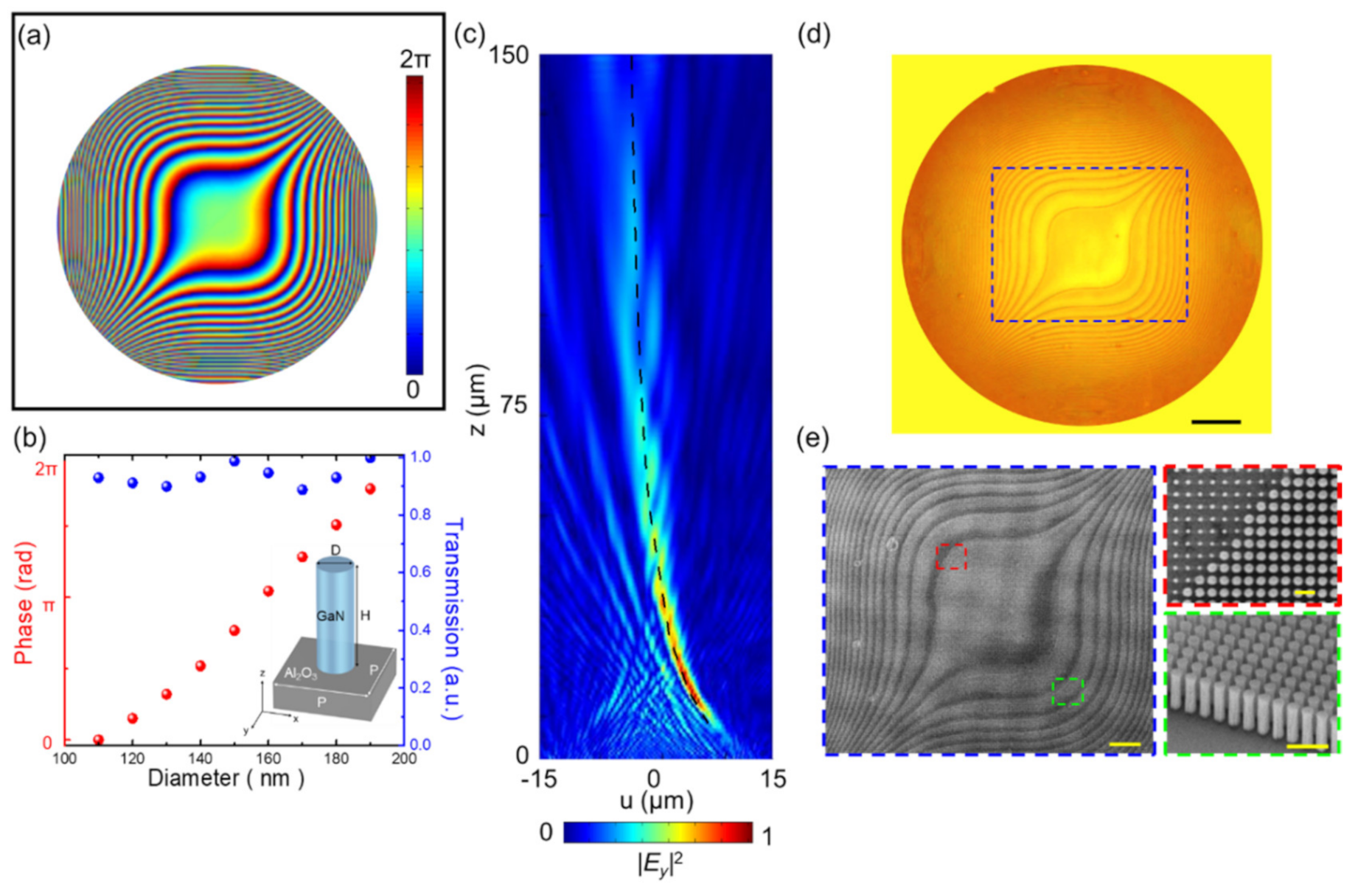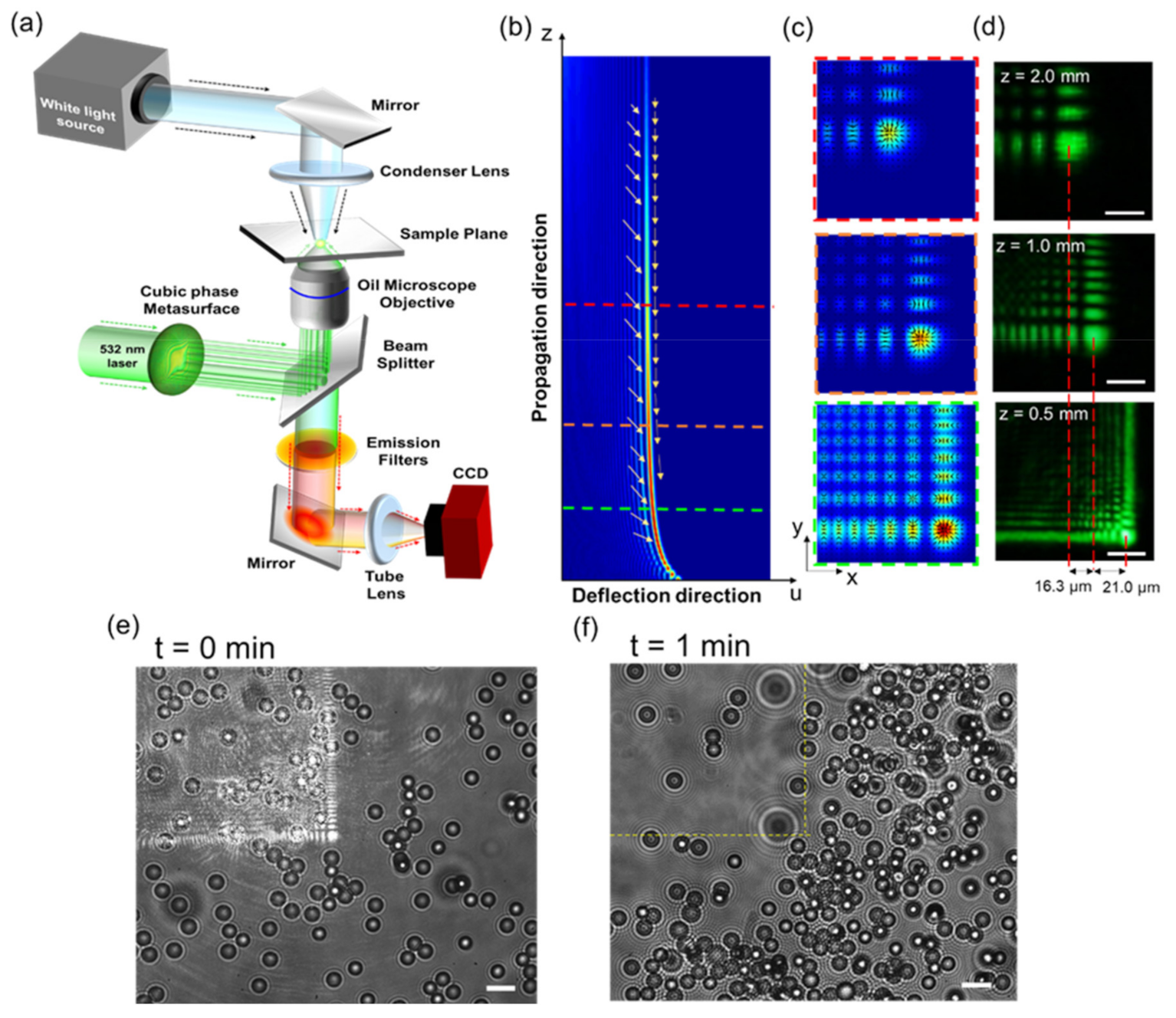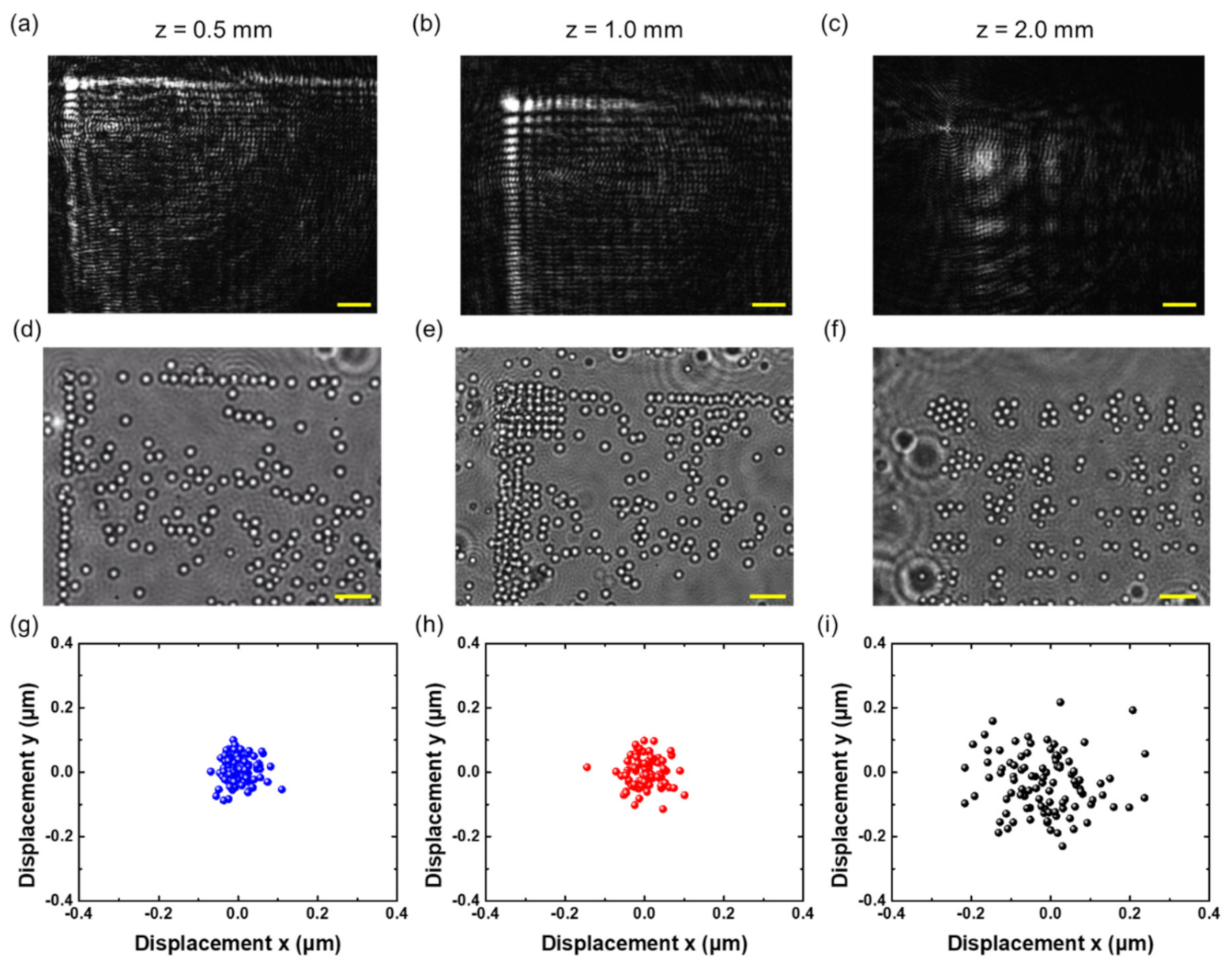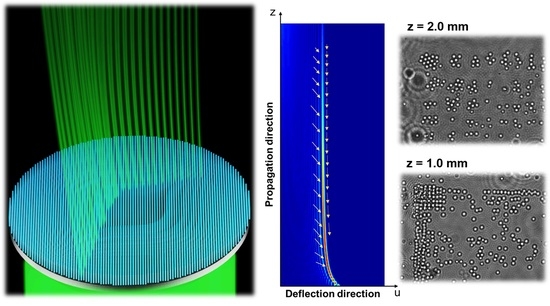Cubic-Phase Metasurface for Three-Dimensional Optical Manipulation
Abstract
:1. Introduction
2. Methods
3. Results
3.1. Simulated Results and Sample Fabrication
3.2. Experimental Verification of Propagation Characteristics of Generated Airy Beam
3.3. 3D Optical Manipulation
4. Discussion
5. Conclusions
Supplementary Materials
Author Contributions
Funding
Data Availability Statement
Conflicts of Interest
References
- Ashkin, A. Acceleration and trapping of particles by radiation pressure. Phys. Rev. Lett. 1970, 24, 156–159. [Google Scholar] [CrossRef] [Green Version]
- Ashkin, A.; Dziedzic, J.M.; Bjorkholm, J.E.; Chu, S. Observation of a single-beam gradient force optical trap for dielectric particles. Opt. Lett. 1986, 11, 288–290. [Google Scholar] [CrossRef] [Green Version]
- Peterman, E.J.; Gittes, F.; Schmidt, C.F. Laser-induced heating in optical traps. Biophys. J. 2003, 84, 1308–1316. [Google Scholar] [CrossRef] [Green Version]
- Wu, J.; Li, Y.; Lu, D.; Liu, Z.; Cheng, Z.; He, L. Measurement of the membrane elasticity of red blood cell with osmotic pressure by optical tweezers. CryoLetters 2009, 30, 89–95. [Google Scholar] [PubMed]
- Shoji, T.; Saitoh, J.; Kitamura, N.; Nagasawa, F.; Murakoshi, K.; Yamauchi, H.; Ito, S.; Miyasaka, H.; Ishihara, H.; Tsuboi, Y. Permanent fixing or reversible trapping and release of DNA micropatterns on a gold nanostructure using continuous-wave or femtosecond-pulsed near-infrared laser light. J. Am. Chem. Soc. 2013, 135, 6643–6648. [Google Scholar] [CrossRef]
- Favre-Bulle, I.A.; Stilgoe, A.B.; Rubinsztein-Dunlop, H.; Scott, E.K. Optical trapping of otoliths drives vestibular behaviours in larval zebrafish. Nat. Commun. 2017, 8, 630. [Google Scholar] [CrossRef] [Green Version]
- Zhu, R.; Avsievich, T.; Popov, A.; Meglinski, I. Optical tweezers in studies of red blood cells. Cells 2020, 9, 545. [Google Scholar] [CrossRef] [Green Version]
- Desgarceaux, R.; Santybayeva, Z.; Battistella, E.; Nord, A.L.; Braun-Breton, C.; Abkarian, M.; Marago, O.M.; Charlot, B.; Pedaci, F. High-resolution photonic force microscopy based on sharp nanofabricated tips. Nano Lett. 2020, 20, 4249–4255. [Google Scholar] [CrossRef]
- Lenton, I.C.D.; Scott, E.K.; Rubinsztein-Dunlop, H.; Favre-Bulle, I.A. Optical tweezers exploring neuroscience. Front. Bioeng. Biotechnol. 2020, 8, 602797. [Google Scholar] [CrossRef] [PubMed]
- Būtaitė, U.G.; Gibson, G.; Ho, Y.-L.D.; Taverne, M.; Taylor, J.M.; Phillips, D.B. Indirect optical trapping using light driven micro-rotors for reconfigurable hydrodynamic manipulation. Nat. Commun. 2019, 10, 1–10. [Google Scholar] [CrossRef]
- Gong, Z.; Pan, Y.-L.; Videen, G.; Wang, C. Optical trapping and manipulation of single particles in air: Principles, technical details, and applications. J. Quant. Spectrosc. Radiat. Transf. 2018, 214, 94–119. [Google Scholar] [CrossRef]
- Rkiouak, L.; Tang, M.; Camp, J.C.J.; McGregor, J.; Watson, I.M.; Cox, R.A.; Kalberer, M.; Ward, A.; Pope, F.D. Optical trapping and Raman spectroscopy of solid particles. Phys. Chem. Chem. Phys. 2014, 16, 11426–11434. [Google Scholar] [CrossRef]
- Redding, B.; Hill, S.C.; Alexson, D.; Wang, C.; Pan, Y.-L. Photophoretic trapping of airborne particles using ultraviolet illumination. Opt. Express 2015, 23, 3630. [Google Scholar] [CrossRef] [PubMed]
- Baumgartl, J.; Mazilu, M.; Dholakia, K. Optically mediated particle clearing using Airy wavepackets. Nat. Photon. 2008, 2, 675–678. [Google Scholar] [CrossRef]
- Zhao, Z.; Zang, W.; Tian, J. Optical trapping and manipulation of Mie particles with Airy beam. J. Opt. 2016, 18, 025607. [Google Scholar] [CrossRef]
- Zheng, Z.; Zhang, B.F.; Chen, H.; Ding, J.; Wang, H.T. Optical trapping with focused Airy beams. Appl. Opt. 2011, 50, 43–49. [Google Scholar] [CrossRef]
- Zhang, P.; Prakash, J.; Zhang, Z.; Mills, M.; Efremidis, N.K.; Christodoulides, D.N.; Chen, Z. Trapping and guiding microparticles with morphing autofocusing Airy beams. Opt. Lett. 2011, 36, 2883–2885. [Google Scholar] [CrossRef]
- Yin, S.; He, F.; Kubo, W.; Wang, Q.; Frame, J.; Green, N.G.; Fang, X. Coherently tunable metalens tweezers for optofluidic particle routing. Opt. Express 2020, 28, 38949–38959. [Google Scholar] [CrossRef] [PubMed]
- Niffenegger, R.J.; Stuart, J.; Sorace-Agaskar, C.; Kharas, D.; Bramhavar, S.; Bruzewicz, C.D.; Loh, W.; Maxson, R.T.; McConnell, R.; Reens, D.; et al. Integrated multi-wavelength control of an ion qubit. Nat. Cell Biol. 2020, 586, 538–542. [Google Scholar] [CrossRef]
- Shi, Y.; Zhao, H.; Chin, L.K.; Zhang, Y.; Yap, P.H.; Ser, W.; Qiu, C.-W.; Liu, A.Q. Optical potential-well array for high-selectivity, massive trapping and sorting at nanoscale. Nano Lett. 2020, 20, 5193–5200. [Google Scholar] [CrossRef]
- Chisholm, C.S.; Thomas, R.; Deb, A.B.; Kjærgaard, N. A three-dimensional steerable optical tweezer system for ultracold atoms. Rev. Sci. Instrum. 2018, 89, 103105. [Google Scholar] [CrossRef] [Green Version]
- Kalume, A.; Beresnev, L.A.; Santarpia, J.; Pan, Y.-L. Detection and characterization of chemical aerosol using laser-trapping single-particle Raman spectroscopy. Appl. Opt. 2017, 56, 6577–6582. [Google Scholar] [CrossRef]
- Kalume, A.; Zhu, E.; Wang, C.; Santarpia, J.; Pan, Y.L. Position-resolved Raman spectra from a laser-trapped single airborne chemical droplet. Opt. Lett. 2017, 42, 5113–5116. [Google Scholar] [CrossRef]
- Efremidis, N.K.; Chen, Z.; Segev, M.; Christodoulides, D.N. Airy beams and accelerating waves: An overview of recent advances. Optica 2019, 6, 686–701. [Google Scholar] [CrossRef] [Green Version]
- Berry, M.V.; Balazs, N.L. Nonspreading wave packets. Am. J. Phys. 1979, 47, 264–267. [Google Scholar] [CrossRef]
- Siviloglou, G.A.; Broky, J.; Dogariu, A.; Christodoulides, D.N. Observation of accelerating Airy beams. Phys. Rev. Lett. 2007, 99, 213901. [Google Scholar] [CrossRef] [PubMed]
- Li, L.; Li, T.; Wang, S.M.; Zhang, C.; Zhu, S.N. Plasmonic Airy beam generated by in-plane diffraction. Phys. Rev. Lett. 2011, 107, 126804. [Google Scholar] [CrossRef] [Green Version]
- Mathis, A.; Courvoisier, F.; Froehly, L.; Furfaro, L.; Jacquot, M.; Lacourt, P.-A.; Dudley, J.M. Micromachining along a curve: Femtosecond laser micromachining of curved profiles in diamond and silicon using accelerating beams. Appl. Phys. Lett. 2012, 101, 071110. [Google Scholar] [CrossRef] [Green Version]
- Vettenburg, T.; Dalgarno, H.I.C.; Nylk, J.; Coll-Lladó, C.; Ferrier, D.; Cizmar, T.; Gunn-Moore, F.J.; Dholakia, K. Light-sheet microscopy using an Airy beam. Nat. Methods 2014, 11, 541–544. [Google Scholar] [CrossRef] [PubMed] [Green Version]
- Wang, J.; Hua, X.; Guo, C.; Liu, W.; Jia, S. Airy-beam tomographic microscopy. Optica 2020, 7, 790–793. [Google Scholar] [CrossRef]
- Liang, Y.; Yan, S.; Wang, Z.; Li, R.; Cai, Y.; He, M.; Yao, B.; Lei, M. Simultaneous optical trapping and imaging in the axial plane: A review of current progress. Rep. Prog. Phys. 2020, 83, 032401. [Google Scholar] [CrossRef]
- Yu, N.; Genevet, P.; Kats, M.A.; Aieta, F.; Tetienne, J.-P.; Capasso, F.; Gaburro, Z. Light propagation with phase discontinuities: Generalized laws of reflection and refraction. Science 2011, 334, 333–337. [Google Scholar] [CrossRef] [Green Version]
- Huang, Y.-W.; Chen, W.T.; Tsai, W.-Y.; Wu, P.C.; Wang, C.-M.; Sun, G.; Tsai, D.P. Aluminum plasmonic multicolor meta-hologram. Nano Lett. 2015, 15, 3122–3127. [Google Scholar] [CrossRef]
- Wang, S.; Wu, P.C.; Su, V.-C.; Lai, Y.-C.; Chu, C.H.; Chen, J.-W.; Lu, S.-H.; Chen, J.; Xu, B.; Kuan, C.-H.; et al. Broadband achromatic optical metasurface devices. Nat. Commun. 2017, 8, 1–9. [Google Scholar] [CrossRef] [PubMed]
- Wu, P.C.; Chen, J.-W.; Yin, C.-W.; Lai, Y.-C.; Chung, T.L.; Liao, C.Y.; Chen, B.H.; Lee, K.-W.; Chuang, C.-J.; Wang, C.-M.; et al. Visible metasurfaces for on-chip polarimetry. ACS Photon. 2018, 5, 2568–2573. [Google Scholar] [CrossRef]
- Wang, S.; Wu, P.C.; Su, V.-C.; Lai, Y.-C.; Chen, M.K.; Kuo, H.Y.; Chen, B.H.; Chen, Y.H.; Huang, T.-T.; Wang, J.-H.; et al. A broadband achromatic metalens in the visible. Nat. Nanotechnol. 2018, 13, 227–232. [Google Scholar] [CrossRef] [PubMed]
- Chen, M.K.; Wu, Y.; Feng, L.; Fan, Q.; Lu, M.; Xu, T.; Tsai, D.P. Principles, functions, and applications of optical metalens. Adv. Opt. Mater. 2021, 9, 2001414. [Google Scholar] [CrossRef]
- Lin, R.J.; Su, V.-C.; Wang, S.; Chen, M.K.; Chung, T.L.; Chen, Y.H.; Kuo, H.Y.; Chen, J.-W.; Chen, J.; Huang, Y.-T.; et al. Achromatic metalens array for full-colour light-field imaging. Nat. Nanotechnol. 2019, 14, 227–231. [Google Scholar] [CrossRef] [PubMed]
- Li, L.; Liu, Z.; Ren, X.; Wang, S.; Su, V.-C.; Chen, M.-K.; Chu, C.H.; Kuo, H.Y.; Liu, B.; Zang, W.; et al. Metalens array-based high-dimensional and multiphoton quantum source. Science 2020, 368, 1487–1490. [Google Scholar] [CrossRef]
- Zhang, S.; Wong, C.L.; Zeng, S.; Bi, R.; Tai, K.; Dholakia, K.; Olivo, M. Metasurfaces for biomedical applications: Imaging and sensing from a nanophotonics perspective. Nanophotonics 2020, 10, 259–293. [Google Scholar] [CrossRef]
- Pahlevaninezhad, H.; Khorasaninejad, M.; Huang, Y.-W.; Shi, Z.; Hariri, L.P.; Adams, D.C.; Ding, V.; Zhu, A.; Qiu, C.-W.; Capasso, F.; et al. Nano-optic endoscope for high-resolution optical coherence tomography in vivo. Nat. Photon. 2018, 12, 540–547. [Google Scholar] [CrossRef]
- Yang, W.; Xiao, S.; Song, Q.; Liu, Y.; Wu, Y.; Wang, S.; Yu, J.; Han, J.; Tsai, D.-P. All-dielectric metasurface for high-performance structural color. Nat. Commun. 2020, 11, 1–8. [Google Scholar] [CrossRef] [Green Version]
- Li, Z.; Cheng, H.; Liu, Z.; Chen, S.; Tian, J. Plasmonic Airy beam generation by both phase and amplitude modulation with metasurfaces. Adv. Opt. Mater. 2016, 4, 1230–1235. [Google Scholar] [CrossRef]
- Yu, B.; Wen, J.; Chen, L.; Zhang, L.; Fan, Y.; Dai, B.; Kanwal, S.; Lei, D.; Zhang, D.; Leihong, Z. Polarization-independent highly efficient generation of Airy optical beams with dielectric metasurfaces. Photon. Res. 2020, 8, 1148. [Google Scholar] [CrossRef]
- Song, E.-Y.; Lee, G.-Y.; Park, H.; Lee, K.; Kim, J.; Hong, J.; Kim, H.; Lee, B. Compact generation of Airy beams with C-aperture metasurface. Adv. Opt. Mater. 2017, 5, 5. [Google Scholar] [CrossRef]
- Li, H.; Hao, W.; Yin, X.; Chen, S.; Chen, L. Broadband generation of Airy beams with hyperbolic metamaterials. Adv. Opt. Mater. 2019, 7, 1900493. [Google Scholar] [CrossRef]
- Guo, Y.; Huang, Y.; Li, X.; Pu, M.; Gao, P.; Jin, J.; Ma, X.; Luo, X. Polarization-controlled broadband accelerating beams generation by single catenary-shaped metasurface. Adv. Opt. Mater. 2019, 7, 7. [Google Scholar] [CrossRef]
- Wu, P.C.; Tsai, W.-Y.; Chen, W.T.; Huang, Y.-W.; Chen, T.-Y.; Chen, J.-W.; Liao, C.Y.; Chu, C.H.; Sun, G.; Tsai, D.P. Versatile polarization generation with an aluminum plasmonic metasurface. Nano Lett. 2016, 17, 445–452. [Google Scholar] [CrossRef]
- Zhang, F.; Zeng, Q.; Pu, M.; Wang, Y.; Guo, Y.; Li, X.; Ma, X.; Luo, X. Broadband and high efficiency accelerating beam generation by dielectric catenary metasurfaces. Nanophotonics 2020, 9, 2829–2837. [Google Scholar] [CrossRef]
- Fan, Q.; Zhu, W.; Liang, Y.; Huo, P.; Zhang, C.; Agrawal, A.; Huang, K.; Luo, X.; Lu, Y.-Q.; Qiu, C.; et al. Broadband generation of photonic spin-controlled arbitrary accelerating light beams in the visible. Nano Lett. 2019, 19, 1158–1165. [Google Scholar] [CrossRef] [PubMed]
- Ju, Z.; Wen, J.; Shi, L.; Yu, B.; Deng, M.; Zhang, D.; Hao, W.; Wang, J.; Chen, S.; Chen, L. Ultra-broadband high-efficiency Airy optical beams generated with all-silicon metasurfaces. Adv. Opt. Mater. 2020, 9, 2001284. [Google Scholar] [CrossRef]
- Wen, J.; Chen, L.; Yu, B.; Nieder, J.B.; Zhuang, S.; Zhang, D.; Lei, D. All-dielectric synthetic-phase metasurfaces generating practical Airy beams. ACS Nano 2021, 15, 1030–1038. [Google Scholar] [CrossRef]
- Guo, W.; Chen, K.; Wang, G.; Luo, X.; Cai, T.; Zhang, C.; Feng, Y. Airy beam generation: Approaching ideal efficiency and ultra wideband with reflective and transmissive metasurfaces. Adv. Opt. Mater. 2020, 8, 8. [Google Scholar] [CrossRef]
- Vyas, S.; Chia, Y.H.; Luo, Y. Conventional volume holography for unconventional Airy beam shapes. Opt. Express 2018, 26, 21979–21991. [Google Scholar] [CrossRef]
- Su, V.-C.; Chu, C.H.; Sun, G.; Tsai, D.P. Advances in optical metasurfaces: Fabrication and applications. Opt. Express 2018, 26, 13148–13182. [Google Scholar] [CrossRef] [PubMed]
- Spesyvtseva, S.E.S.; Dholakia, K. Trapping in a material world. ACS Photon. 2016, 3, 719–736. [Google Scholar] [CrossRef] [Green Version]
- Liang, Y.; Yan, S.; Yao, B.; Lei, M. Direct observation and characterization of optical guiding of microparticles by tightly focused non-diffracting beams. Opt. Express 2019, 27, 37975–37985. [Google Scholar] [CrossRef]
- Sarshar, M.; Wong, W.T.; Anvari, B. Comparative study of methods to calibrate the stiffness of a single-beam gradient-force optical tweezers over various laser trapping powers. J. Biomed. Opt. 2014, 19, 115001. [Google Scholar] [CrossRef] [PubMed] [Green Version]
- Yu, S.; Lu, J.; Ginis, V.; Kheifets, S.; Lim, S.W.D.; Qiu, M.; Gu, T.; Hu, J.; Capasso, F. On-chip optical tweezers based on freeform optics. Optica 2021, 8, 409–414. [Google Scholar] [CrossRef]
- Tkachenko, G.; Stellinga, D.; Ruskuc, A.; Chen, M.; Dholakia, K.; Krauss, T.F. Optical trapping with planar silicon metalenses. Opt. Lett. 2018, 43, 3224–3227. [Google Scholar] [CrossRef] [PubMed]
- Meijering, E.; Dzyubachyk, O.; Smal, I. Methods for cell and particle tracking. Methods Enzymol. 2012, 504, 183–200. [Google Scholar] [CrossRef] [PubMed]
- Plidschun, M.; Ren, H.; Kim, J.; Förster, R.; Maier, S.A.; Schmidt, M.A. Ultrahigh numerical aperture meta-fibre for flexible optical trapping. Light Sci. Appl. 2021, 10, 1–11. [Google Scholar] [CrossRef]
- Aiello, M.D.; Backer, A.S.; Sapon, A.J.; Smits, J.; Perreault, J.D.; Llull, P.; Acosta, V.M. Achromatic varifocal metalens for the visible spectrum. ACS Photon. 2019, 6, 2432–2440. [Google Scholar] [CrossRef] [Green Version]
- Colburn, S.; Zhan, A.; Majumdar, A. Varifocal zoom imaging with large area focal length adjustable metalenses. Optica 2018, 5, 825–831. [Google Scholar] [CrossRef]
- Luo, Y.; Chu, C.H.; Vyas, S.; Kuo, H.Y.; Chia, Y.H.; Chen, M.K.; Shi, X.; Tanaka, T.; Misawa, H.; Huang, Y.-Y.; et al. Varifocal metalens for optical sectioning fluorescence microscopy. Nano Lett. 2021, 21, 5133–5142. [Google Scholar] [CrossRef] [PubMed]





| Position Variance | z = 0.5 mm | z = 1.0 mm | z = 2.0 mm |
|---|---|---|---|
| [μm2] | 0.0010 | 0.0014 | 0.0096 |
| [μm2] | 0.0012 | 0.0016 | 0.0092 |
| Position Variance | z = 0.5 mm | z = 1.0 mm | z = 2.0 mm |
|---|---|---|---|
| x [pN/μm] | 4.011 | 3.054 | 0.421 |
| y [pN/μm] | 3.493 | 2.929 | 0.441 |
Publisher’s Note: MDPI stays neutral with regard to jurisdictional claims in published maps and institutional affiliations. |
© 2021 by the authors. Licensee MDPI, Basel, Switzerland. This article is an open access article distributed under the terms and conditions of the Creative Commons Attribution (CC BY) license (https://creativecommons.org/licenses/by/4.0/).
Share and Cite
Kuo, H.Y.; Vyas, S.; Chu, C.H.; Chen, M.K.; Shi, X.; Misawa, H.; Lu, Y.-J.; Luo, Y.; Tsai, D.P. Cubic-Phase Metasurface for Three-Dimensional Optical Manipulation. Nanomaterials 2021, 11, 1730. https://doi.org/10.3390/nano11071730
Kuo HY, Vyas S, Chu CH, Chen MK, Shi X, Misawa H, Lu Y-J, Luo Y, Tsai DP. Cubic-Phase Metasurface for Three-Dimensional Optical Manipulation. Nanomaterials. 2021; 11(7):1730. https://doi.org/10.3390/nano11071730
Chicago/Turabian StyleKuo, Hsin Yu, Sunil Vyas, Cheng Hung Chu, Mu Ku Chen, Xu Shi, Hiroaki Misawa, Yu-Jung Lu, Yuan Luo, and Din Ping Tsai. 2021. "Cubic-Phase Metasurface for Three-Dimensional Optical Manipulation" Nanomaterials 11, no. 7: 1730. https://doi.org/10.3390/nano11071730
APA StyleKuo, H. Y., Vyas, S., Chu, C. H., Chen, M. K., Shi, X., Misawa, H., Lu, Y.-J., Luo, Y., & Tsai, D. P. (2021). Cubic-Phase Metasurface for Three-Dimensional Optical Manipulation. Nanomaterials, 11(7), 1730. https://doi.org/10.3390/nano11071730







